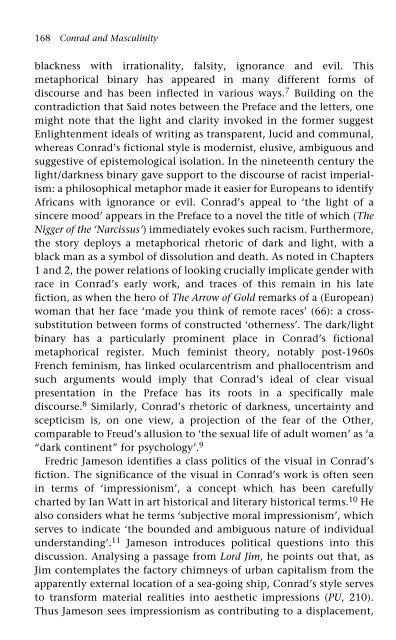Conrad and Masculinity
Conrad and Masculinity
Conrad and Masculinity
You also want an ePaper? Increase the reach of your titles
YUMPU automatically turns print PDFs into web optimized ePapers that Google loves.
168 <strong>Conrad</strong> <strong>and</strong> <strong>Masculinity</strong><br />
blackness with irrationality, falsity, ignorance <strong>and</strong> evil. This<br />
metaphorical binary has appeared in many different forms of<br />
discourse <strong>and</strong> has been inflected in various ways. 7 Building on the<br />
contradiction that Said notes between the Preface <strong>and</strong> the letters, one<br />
might note that the light <strong>and</strong> clarity invoked in the former suggest<br />
Enlightenment ideals of writing as transparent, lucid <strong>and</strong> communal,<br />
whereas <strong>Conrad</strong>’s fictional style is modernist, elusive, ambiguous <strong>and</strong><br />
suggestive of epistemological isolation. In the nineteenth century the<br />
light/darkness binary gave support to the discourse of racist imperialism:<br />
a philosophical metaphor made it easier for Europeans to identify<br />
Africans with ignorance or evil. <strong>Conrad</strong>’s appeal to ‘the light of a<br />
sincere mood’ appears in the Preface to a novel the title of which (The<br />
Nigger of the ‘Narcissus’) immediately evokes such racism. Furthermore,<br />
the story deploys a metaphorical rhetoric of dark <strong>and</strong> light, with a<br />
black man as a symbol of dissolution <strong>and</strong> death. As noted in Chapters<br />
1 <strong>and</strong> 2, the power relations of looking crucially implicate gender with<br />
race in <strong>Conrad</strong>’s early work, <strong>and</strong> traces of this remain in his late<br />
fiction, as when the hero of The Arrow of Gold remarks of a (European)<br />
woman that her face ‘made you think of remote races’ (66): a crosssubstitution<br />
between forms of constructed ‘otherness’. The dark/light<br />
binary has a particularly prominent place in <strong>Conrad</strong>’s fictional<br />
metaphorical register. Much feminist theory, notably post-1960s<br />
French feminism, has linked ocularcentrism <strong>and</strong> phallocentrism <strong>and</strong><br />
such arguments would imply that <strong>Conrad</strong>’s ideal of clear visual<br />
presentation in the Preface has its roots in a specifically male<br />
discourse. 8 Similarly, <strong>Conrad</strong>’s rhetoric of darkness, uncertainty <strong>and</strong><br />
scepticism is, on one view, a projection of the fear of the Other,<br />
comparable to Freud’s allusion to ‘the sexual life of adult women’ as ‘a<br />
“dark continent” for psychology’. 9<br />
Fredric Jameson identifies a class politics of the visual in <strong>Conrad</strong>’s<br />
fiction. The significance of the visual in <strong>Conrad</strong>’s work is often seen<br />
in terms of ‘impressionism’, a concept which has been carefully<br />
charted by Ian Watt in art historical <strong>and</strong> literary historical terms. 10 He<br />
also considers what he terms ‘subjective moral impressionism’, which<br />
serves to indicate ‘the bounded <strong>and</strong> ambiguous nature of individual<br />
underst<strong>and</strong>ing’. 11 Jameson introduces political questions into this<br />
discussion. Analysing a passage from Lord Jim, he points out that, as<br />
Jim contemplates the factory chimneys of urban capitalism from the<br />
apparently external location of a sea-going ship, <strong>Conrad</strong>’s style serves<br />
to transform material realities into aesthetic impressions (PU, 210).<br />
Thus Jameson sees impressionism as contributing to a displacement,




